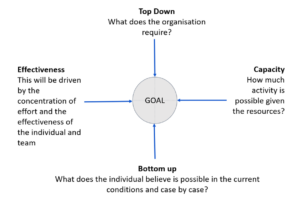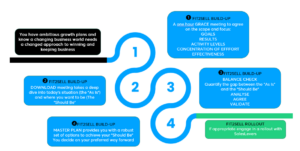Planning for the year ahead
Do it now!
What’s your plan for success in 2024? The decisions you take over the coming weeks will determine whether you get off to a flying start or are playing “catch up” throughout 2024.
Now is the time to be forming that plan.
Get the targets right
Good goals motivate! Get the targets right and the job becomes so much easier. Yet Salesforce’s research suggest that 54% of salespeople expect to miss their quota. How do you plan to avoid being in this stark set of numbers?
Try the crosshairs approach to goal setting developed by SalesLevers.

- Most of us will need to start with “top down”. The business informs us of the result it requires from us. The board tell the FD what the final figure should look like. The FD calculates the top line sales needed to deliver the bottom line result (and adds in a “fudge factor” just in case. The figure may (or may not) have taken into account the market trends. The sales director splits the required result between the sales team, adding their own buffer just in case! By the time the top down v target reaches the front line it has increased significantly and may have little link with reality.
- In a VUCA world (volatile, uncertain, complex and ambiguous) rigid, top down approaches rarely work when it comes to setting goals, targets, quotas. So, we need to validate the top-down demand with a bottom up approach. This involves asking each salesperson for their view of what they believe they will achieve (they may have their reducing “fudge factor”!) It can be based on the year-to-date and predicted full year result but in changing times it may be better to use a zeroed approach simply looking forward at the coming year. It’s always good to start with the key accounts. They are often easier to predict and may well deliver the majority of your result. 90% of sales from the top 20% of customers is not uncommon.
- Now look at your capacity. What will your coverage model allow you to deliver? Is there enough capacity to allow for the required level of sales activities?
- Finally consider the effectiveness of the selling team. If they are currently converting one in ten quotes, then there will need to be a lot more activity than if they convert one in three.
The days of accepting the top down figure and dividing equally between the salespeople are (or should!) long gone. The cross hairs approach gives a validated figure that everyone can believe in.
But what happens if the top-down figure is not validated by the other three dimensions of a cross-hair? Well, armed with the cross-hairs data, we may be able to challenge the top-down goals but as Confucius put it: “When it is obvious that the goals cannot be reached, don’t adjust the goals, adjust the action steps.”
It’s time to plan with ACE
Use the ACE up your sleeve.
There are basically three levers we can use to change the sales result.
- Activities: We can do more selling. That might mean planning budget to hire more salespeople but first look at your utilisation. Earlier this year we helped a construction materials business identify that their salespeople were spending less than 19% of their time in active selling. They are now on track to 35%. This may seem low but in reality, it’s not a bad figure! We commissioned a researcher at Glasgow Caledonian University (GCU) to analyse one organisation who started using our SalesRelay app. The data showed an 86% increase in sales activities over a twelve month period. That’s an 86% increase in sales activities for no increase in fixed costs. The quickest and easiest way to bridge the gap between the result you need and the result you are predicting is to get the activity level up.
Of course, it’s not the only lever to pull!
- Concentration of effort: Are we talking about the right things to the right people in the right organisations?
- The right things: What is your product strategy for the coming year? What are the products that are most likely to deliver your market share or margin targets? Are your people equipped with the knowledge they need to achieve this? Do they have the required capability, confidence and commitment? Have you planned in the best way to create and curate your content?
- The right organisations: What is your ideal customer profile for the year ahead? Are you focusing on growing customers? Take a look at these numbers.

If you focus on a customer whose overall business is growing by 10%, even if you don’t increase your share of wallet for every 100 units you sold this year you will be selling 146 by year 5. An automatic increase of 46%. If, however you focus ion a customer who is declining by 10% a year then after 5 years you will only have 66% of business. A huge differential simply by picking winners. In addition are you putting enough emphasis on your key accounts. Siemens analysed their strategic accounts over a 10 year period and found their strategic accounts grew 2.4 times faster than their “standard” accounts. Growing key and strategic accounts is one of the most effective way to drive growth.
- The right people. The GCU analysis referred to above also looked at concentration of effort. When the salespeople visited contacts with “manager” in their titles they achieved a close rate of 27% but when they visited “directors” they achieved a 56% close rate. Clearly talking to the right people has a massive impact on effectiveness and efficiency. In the same way businesses that are looking to drive growth through CSR or ESG are seeing that they need to be talking to different people from the past – not just the operations management or the procurement specialist but the head of sustainability, the director of strategy.
Changing the concentration of effort can be a powerful lever to increase the sales result.
3. The third lever is effectiveness. Are we doing things in the right way? As you plan for the year ahead consider the effectiveness of the sales team. It’s useful to do this on two levels.
Individuals: Do your salespeople have what it will take to deliver your planned result?
Think in terms of TASKS.
- Talent: The innate characteristics that will make this possible. Talent is rarely trainable. It is the set of underlying characteristics that make us who we are. It is therefore more a recruitment and retention matter than a development matter.
- Attitude: The mindset that will deliver the result for you. E.g., resilience, curiosity, grounded optimism, problem finding rather than just problem solving.
- Skills: “The ability to do”. McKinsey research indicates that fewer than 50% of organizations believe a clear majority of their salespeople have the skills to be successful. Some of the key skills we are seeing as pivotal for the year ahead include analytical and quantitative skills, hybrid selling skills, key account management skills, negotiating and price handling.
- Knowledge: This underpins the “ability to do”. Clearly product knowledge is vital. We also talk bout five levels of knowledge –
- the big picture (understanding the world our customers work in – PESTEL)
- Sectoral knowledge – the drivers, the differentiators of their sector.
- Customer knowledge – understanding the customer’s business rather than just their buying needs.
- Deal knowledge – what we need to know to win the deal.
- People knowledge – understand our contacts’ motivations, personae etc.
- Style: This is the way our salespeople deploy their talent, attitude, skills and knowledge. Does your business have a distinctive selling style that is recognised and appreciated by your customers? Could you develop this over the coming year?
This is ACE. Use it as a planning tool:
Activities: Are doing enough?
Concentration of effort: of the right things with the right people in the right organisations
Effectiveness: In the right way?
Try our free ACE diagnostic to see where the priorities are.
Plan for growth
If you have ambitious growth plans, it may well be worth talking to us about two powerful approaches that have been delivering significant and measurable results.
Fit2Sell and Fit4KAM both initial phase (in blue below) of clarifying, validating and agreeing your desired goal and the current state and then creating a robust project plan to get you from “here” to “there” faster, more easily or less expensively.

Conclusions
Of the 500 or so businesses we have worked with over the years it is clear that the most successful are those who have done their sales planning earlier than their competitors and better than their competitors.
A good sales plan may not guarantee success for the year ahead, but the lack of a sales plan means that the result is at best uncertain.
In our rapidly changing world, the right kind of sales planning done at the right time makes all the difference.
If you would like to discuss any of the matters raised in this paper do contact us:

